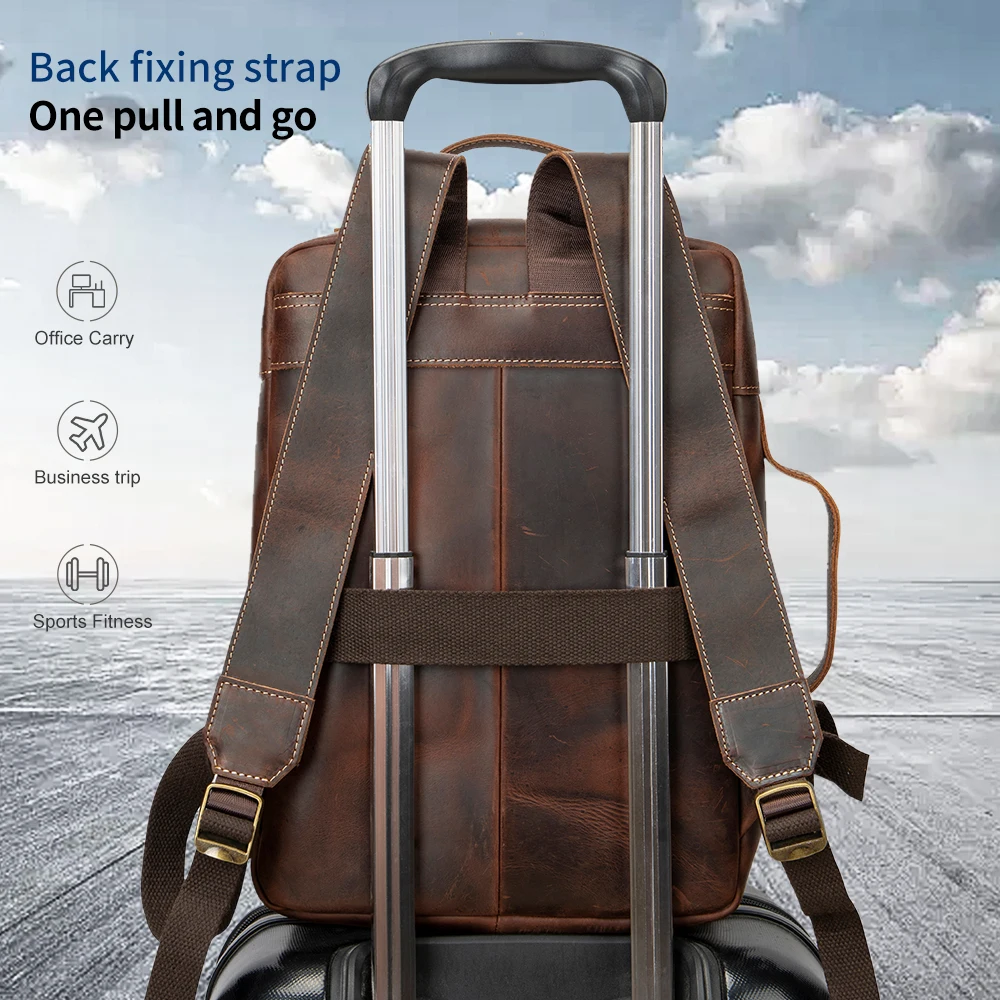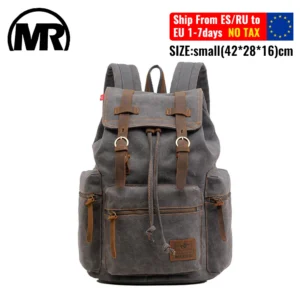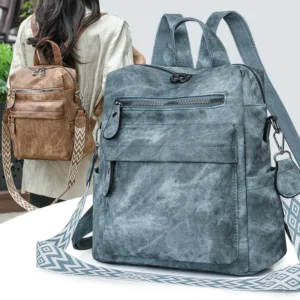Introduction: Understanding the Importance of Proper Leather Backpack Care
A premium leather backpack represents more than just a carrying solution – it’s an investment that can last for decades with the right care. Unlike synthetic materials that deteriorate over time, quality leather actually develops character and beauty with proper maintenance. Understanding how to clean your leather backpack correctly is crucial to preserving its appearance, structural integrity, and overall lifespan.
Leather is essentially a “living material” that responds to its environment and the care it receives. Without appropriate cleaning and conditioning, leather can dry out, crack, stain, or develop mold – issues that can significantly reduce both the aesthetics and functionality of your backpack.
Different types of leather require specific cleaning approaches. What works perfectly for full-grain leather might damage suede or nubuck. Using the wrong cleaner can strip natural oils, cause discoloration, or even break down the leather fibers permanently.
In this comprehensive guide, you’ll learn:
– How to identify your backpack’s leather type
– Which cleaners work best for different leather varieties
– Proper application techniques for each cleaner type
– Regular maintenance tips to extend your backpack’s life
With quality leather goods lasting up to 5-7 times longer than synthetic alternatives when properly maintained, mastering these care techniques offers substantial value for your investment.
Leather conditioning and waterproofing represents an essential component of comprehensive leather care that we’ll explore throughout this guide.
Understanding Different Leather Types and Their Cleaning Needs
Before selecting a leather cleaner, it’s crucial to identify what type of leather your backpack is made from. Each variety has unique characteristics that influence its cleaning requirements.
Full-Grain Leather
Full-grain leather is the highest quality option, featuring the entire outer layer of the hide with its natural grain pattern intact. This premium material:
– Develops a beautiful patina over time
– Contains natural oils that need preservation
– Requires gentle cleaning to maintain its character
– Benefits from regular conditioning to prevent drying
Many discerning customers choose full-grain leather backpacks for their exceptional durability and aging characteristics. When cleaning full-grain leather, avoid harsh chemicals that can strip its natural properties. Understanding why full-grain leather offers better quality helps appreciate its unique care requirements.
Top-Grain Leather
Top-grain leather has been lightly sanded to remove imperfections, creating a more uniform appearance. Its characteristics include:
– A thinner, more flexible structure than full-grain
– A protective coating that resists stains
– Less natural oil content, requiring more frequent conditioning
– Greater susceptibility to drying out without proper care
When cleaning top-grain leather, you’ll need products that work with its protective finish without damaging the thinner material.
Suede and Nubuck
These leathers feature a velvety, raised nap that requires specialized care:
– Cannot tolerate most liquid cleaners
– Needs specialized brushes and erasers for cleaning
– Requires dedicated suede/nubuck protectants
– Shows water damage easily without proper protection
Standard leather conditioners can permanently damage suede and nubuck, making proper identification essential before cleaning.
Patent Leather
With its glossy, sealed finish, patent leather has unique requirements:
– Resists water and most stains
– Needs non-alcohol cleaning solutions to prevent finish damage
– Shows fingerprints and smudges easily
– Cannot absorb traditional conditioners
Pebbled and Textured Leather
Textured leathers feature an embossed pattern that can trap dirt in crevices:
– Requires brushes to clean effectively between texture points
– Benefits from spray cleaners that reach into patterns
– Often needs less conditioning than smooth leathers
– Can hide minor scratches and wear better than smooth finishes
Identifying your backpack’s leather type is relatively simple. Full-grain and top-grain typically have a smooth, natural appearance with visible pores. Suede and nubuck have a fuzzy, velvet-like texture. Patent leather has a mirror-like shine, while pebbled leather features a consistent raised pattern.
Essential Categories of Leather Cleaners for Backpacks
When selecting a leather cleaner for your backpack, understanding the main categories available helps match the right product to your specific needs. All quality leather cleaners share certain characteristics, regardless of their form:
- pH balance (ideally neutral, around 7 on the pH scale) to prevent leather damage
- Gentle formulations free from harsh alcohols, bleaches, or ammonia
- Compatibility with the natural composition of leather
It’s important to distinguish between cleaning and conditioning. Cleaning removes dirt, oils, and contaminants, while conditioning replenishes moisture and essential oils. Many backpack owners make the mistake of conditioning without properly cleaning first, which can seal in dirt and cause long-term damage.
Using inappropriate products can cause significant harm – studies show that household cleaners containing alkaline ingredients can increase leather’s deterioration rate by up to 40%. Similarly, products formulated for one leather type may damage another, such as using oil-based products on suede.
The right cleaner should match both your leather type and the specific cleaning challenge you face. Throughout the next sections, we’ll explore each major cleaner category in detail so you can develop an ultimate guide for conditioning your leather backpack with confidence.
Liquid Leather Cleaners: Versatility for General Maintenance
Liquid leather cleaners represent the most versatile category of leather care products. Typically sold in bottles, these cleaners consist of mild detergents suspended in water or alcohol solutions designed specifically for leather.
When to Use Liquid Cleaners
These cleaners excel in several scenarios:
– Removing general surface dirt and grime
– Cleaning larger areas efficiently
– Addressing accumulated oils from handling
– Preparing leather for conditioning
Application Method
To apply liquid cleaner effectively:
1. Dampen (don’t soak) a soft, lint-free cloth with the cleaner
2. Gently work the solution into the leather using circular motions
3. Cover small sections at a time, working methodically
4. Wipe away excess cleaner before it dries
5. Allow the backpack to dry naturally away from direct heat
Pros of Liquid Cleaners
- Versatile for most smooth leather types
- Effective at lifting embedded dirt
- Easy to control application amount
- Generally affordable and widely available
- Works well for regular maintenance
Cons of Liquid Cleaners
- Risk of oversaturation if used improperly
- May require longer drying time than other options
- Not suitable for suede or nubuck
- Some formulas can be too harsh for delicate leathers
When using liquid cleaners, watch for signs of oversaturation: darkening leather that feels cold to the touch or excessive softening of the material. Most leather should dry within 1-3 hours after cleaning, depending on humidity levels.
For optimal results, select leather care products specifically designed for backpacks rather than generic leather cleaners, as these often account for the unique wear patterns and contamination that backpacks experience.
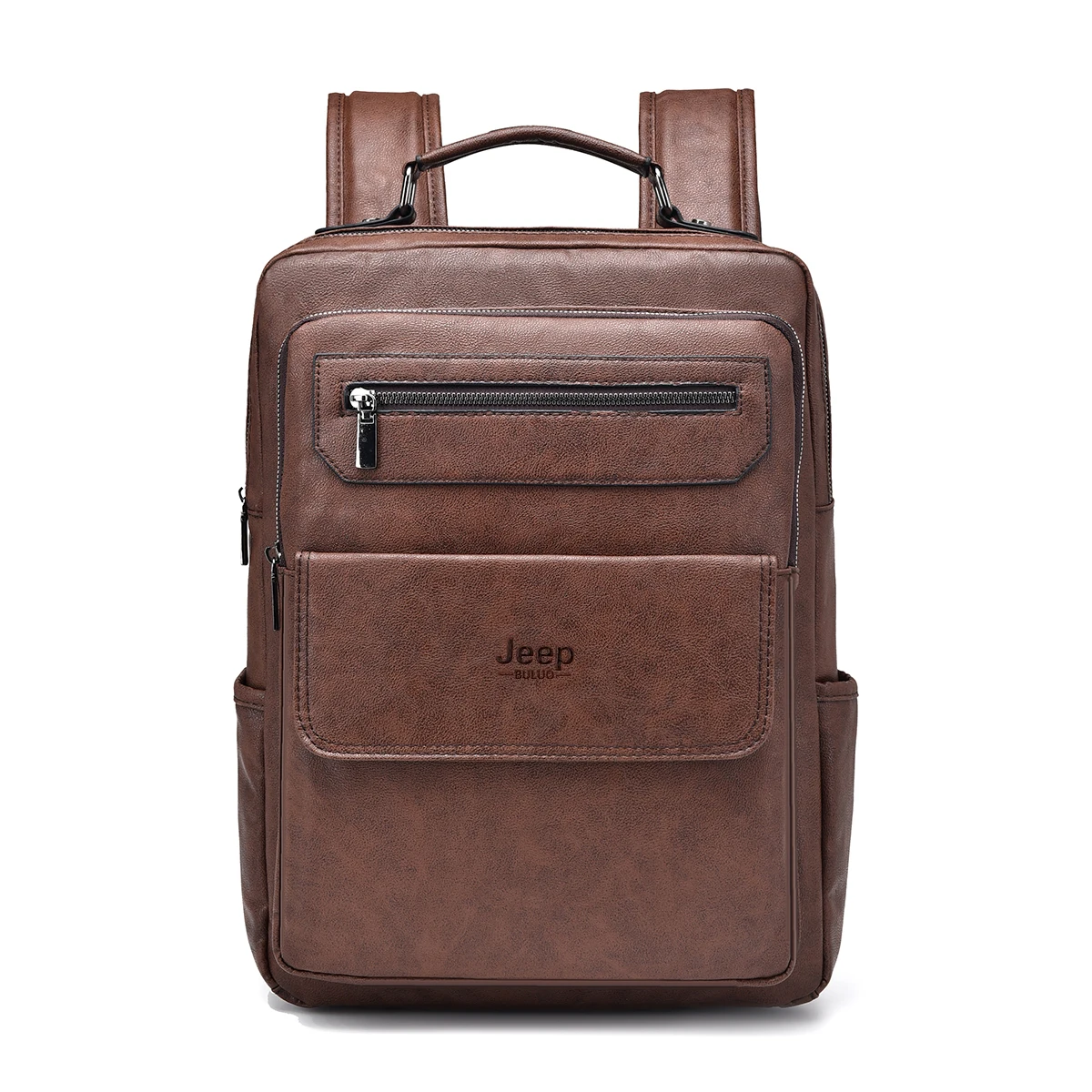
Cream Leather Cleaners and Conditioners: Deep Nourishment
Cream leather cleaners and conditioners provide deeper nourishment than their liquid counterparts. These products typically have a thick, buttery consistency and contain oils, waxes, or lanolin that penetrate leather fibers while cleaning.
Types of Cream Products
There are two main varieties of cream products:
– Cleaning creams: Focus primarily on dirt removal with mild conditioning properties
– Conditioning creams with cleaning agents: Primarily condition while offering light cleaning capabilities
Cream products shine when addressing leather that shows signs of dryness, such as stiffness, fading color, or a lack of suppleness. They’re particularly valuable for leather backpacks that face frequent exposure to dry environments or infrequent conditioning.
Application Techniques
For optimal results with cream products:
1. Ensure leather is clean or apply to a slightly damp surface after liquid cleaning
2. Use a small amount on a soft cloth or applicator sponge
3. Work the product into the leather using small circular motions
4. Pay special attention to dry areas or heavy creases
5. Allow appropriate absorption time (typically 5-15 minutes)
6. Buff with a clean cloth to remove excess product and enhance shine
Pros of Cream Cleaners/Conditioners
- Provide deep nourishment while cleaning
- Help restore suppleness to dry leather
- Create a protective barrier against future contamination
- Often impart a rich luster to the leather
- Typically longer-lasting effects than liquids
Cons of Cream Cleaners/Conditioners
- Can leave residue if overapplied
- May darken some lighter-colored leathers
- Require more effort to work into the leather
- Not suitable for suede or nubuck
- Some contain waxes that build up over time
Understanding when leather should dry before conditioning is crucial for achieving optimal results with cream products. Generally, leather should be slightly damp but not wet when applying conditioner – this helps the product penetrate more deeply while preventing oversaturation.
Spray Leather Cleaners: Convenience and Even Application
Spray leather cleaners offer unmatched convenience with their easy application method. These products typically contain cleaning agents in a fine mist that distributes evenly across leather surfaces.
Formulation Differences
Spray cleaners differ from other types in several key ways:
– Lower viscosity for aerosol or pump delivery
– Faster evaporation rates to prevent oversaturation
– Often include water repellents or UV protectants
– May contain silicones for shine enhancement
Application Technique
To apply spray cleaners effectively:
1. Hold the bottle 6-8 inches from the backpack surface
2. Apply in a light, even layer using a sweeping motion
3. Allow the product to sit briefly (follow product instructions)
4. Wipe with a clean cloth, using gentle pressure
5. Repeat for heavily soiled areas
Pros of Spray Cleaners
- Quick and easy application
- Even distribution across textured surfaces
- Excellent for reaching crevices and seams
- Ideal for quick touch-ups between deep cleanings
- Less risk of oversaturation with controlled application
Cons of Spray Cleaners
- May not provide enough cleaning power for heavy soil
- Can drift onto hardware or non-leather components
- Often more expensive per use than liquid cleaners
- Some formulas leave a shine that’s too glossy for vintage looks
- Aerosol versions may contain propellants that dry leather over time
Spray cleaners work particularly well for vintage leather backpacks with detailed texturing or hardware where precise application helps avoid damage to aging components.
When using spray cleaners, protect any exposed hardware by covering with tape or carefully wiping immediately after application to prevent potential tarnishing or residue build-up on metal elements.
Leather Wipes: On-the-Go Solutions
Leather cleaning wipes provide the ultimate convenience for travelers and commuters who need to address spills or dirt on the go. These pre-moistened cloths contain gentle cleaning solutions designed for quick touch-ups.
Composition and Purpose
Quality leather wipes typically feature:
– Mild cleaning agents suitable for leather
– Light conditioning ingredients like coconut oil or lanolin
– pH-balanced formulations
– Low alcohol content to prevent drying
– Individual packaging or resealable containers to prevent drying out
Appropriate Use Cases
Leather wipes excel in specific scenarios:
– Removing fresh spills before they set
– Cleaning surface dirt during travel
– Quick refreshes before meetings or events
– Light cleaning of high-touch areas like handles
– Addressing small, isolated stains
Pros of Leather Wipes
- Extremely portable and convenient
- No risk of spilling liquid cleaners
- Pre-measured cleaning solution prevents oversaturation
- Combination of cleaning and light conditioning
- No need for additional applicators or cloths
Cons of Leather Wipes
- Limited effectiveness for deep cleaning
- Higher cost per use than other cleaning methods
- Potential for inadequate cleaning of heavily soiled areas
- May dry out if not stored properly
- Some contain preservatives that can affect sensitive leathers
For commuters especially, incorporating wipes into your leather maintenance routine provides a practical way to address daily grime before it becomes embedded in the leather.
When selecting leather wipes, avoid those containing high alcohol concentrations, strong fragrances, or antibacterial ingredients, as these can dry out or damage leather over time. Look instead for wipes specifically formulated for leather furniture or automotive interiors, which tend to have appropriate formulations for backpacks.
Saddle Soap: Traditional but Specialized
Saddle soap represents one of the oldest and most traditional leather cleaning solutions, originally developed for horse tack and riding equipment. Its rich history makes it a go-to for many leather enthusiasts, but it requires understanding its specific applications.
Composition and Properties
Traditional saddle soap typically contains:
– Mild soap for cleaning
– Beeswax or other waxes for protection
– Lanolin or neatsfoot oil for conditioning
– A firm paste consistency that softens with application
Appropriate Leather Types
Saddle soap works best with:
– Full-grain, vegetable-tanned leathers
– Oil-tanned work leathers
– Thick, robust leather varieties
– Heavily soiled leather that needs deep cleaning
⚠️ Warning: Saddle soap can be too harsh and drying for many modern, chrome-tanned leathers used in contemporary backpacks. It may strip factory finishes on fashion leathers.
Application Technique
For proper saddle soap application:
1. Dampen a clean sponge or cloth
2. Work up a light lather on the soap surface
3. Apply to leather in circular motions
4. Use minimal water to prevent oversaturation
5. Wipe away residue completely with a clean, damp cloth
6. Allow to dry fully
7. Follow with appropriate conditioner to restore moisture
Pros of Saddle Soap
- Excellent for deep cleaning heavily soiled leather
- Provides cleaning and some conditioning in one product
- Long shelf life compared to liquid products
- Traditional, time-tested formula
- Effective at removing built-up grime and old products
Cons of Saddle Soap
- Can be drying if not followed with conditioning
- May alter color on some leathers
- Requires more effort to apply properly
- Can build up if not completely removed
- Too harsh for many modern leather finishes
Saddle soap can be appropriate for certain men’s leather backpacks designed with thicker, more traditional leathers, but should be used cautiously on lightweight or fashion-forward styles.
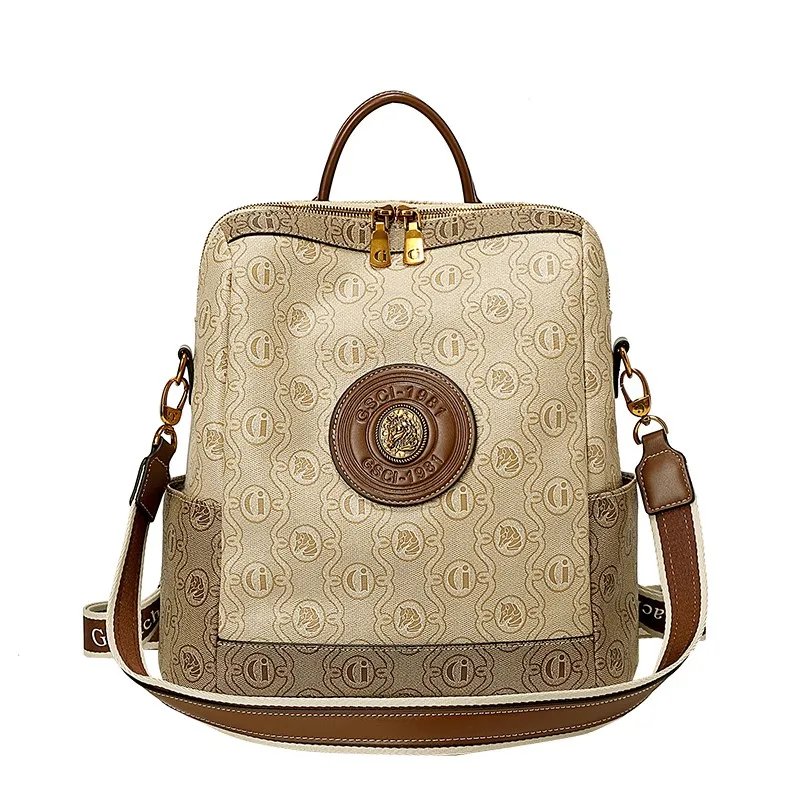
Natural and DIY Solutions: When and How to Use Them Safely
Natural and DIY leather cleaning solutions offer budget-friendly alternatives when commercial products aren’t available. When used correctly, these household items can effectively clean leather without causing damage.
Safe Natural Alternatives
Several household items can safely clean leather in specific situations:
Mild Soap Solution
– Mix 2-3 drops of mild dish soap in 1 cup of distilled water
– Ideal for: General surface cleaning of finished leathers
– Application: Dampen cloth, wring thoroughly, wipe gently, follow with clean water wipe
White Vinegar Solution
– Mix 1 part white vinegar with 8 parts water
– Ideal for: Removing salt stains, light mildew, or alkaline residue
– Application: Apply with cloth, wipe with clean water afterward, dry thoroughly
Lemon Juice and Cream of Tartar
– Equal parts mixed to form paste
– Ideal for: Lightening dark stains on light-colored leather
– Application: Apply to stain, leave for 10 minutes, wipe clean
⚠️ Warning: Never use household products including:
– Bleach (permanently damages leather fibers)
– Ammonia (breaks down leather structure)
– Alcohol products (dries and cracks leather)
– Furniture polish (builds up and attracts dirt)
– General purpose cleaners (contain harsh chemicals)
Testing First
Always test any DIY solution in an inconspicuous area first, such as the bottom of the backpack or inside a pocket. Wait 24 hours to ensure no adverse reactions before using on visible areas.
For travelers dealing with unexpected spills, understanding DIY leather care options can save your backpack when commercial products aren’t available.
The most important principle with natural cleaners is thoroughness – any residue left behind can attract dirt or cause discoloration, so complete removal with a clean, damp cloth is essential.
Step-by-Step Leather Backpack Cleaning Process
Regardless of which cleaning products you choose, following a methodical cleaning process ensures the best results without damaging your leather backpack.
1. Preparation (5 minutes)
- Empty all pockets and compartments completely
- Remove any detachable straps or accessories
- Vacuum interior using low suction with soft brush attachment
- Gently brush exterior with soft-bristled brush to remove loose dirt
- Place newspaper or towels on your work surface
2. Surface Cleaning (5-10 minutes)
- Wipe entire backpack with a clean, slightly damp cloth to remove surface dust
- Pay special attention to seams and crevices where dirt accumulates
- Allow to air dry if noticeably damp after this step
3. Spot Testing (5 minutes + wait time)
- Select an inconspicuous area (bottom corner or inside flap)
- Apply a small amount of your chosen cleaner
- Wait according to product instructions (typically 10-30 minutes)
- Check for adverse reactions like discoloration, darkening, or texture changes
4. Cleaner Application (15-20 minutes)
- Work in small sections, starting from top to bottom
- Apply cleaner using appropriate method for your product type
- Use gentle circular motions with minimal pressure
- Address heavily soiled areas with slightly more product rather than more pressure
- Wipe away excess cleaner before moving to next section
5. Drying (2-24 hours)
- Air dry naturally away from direct heat sources
- Maintain backpack shape by stuffing with clean paper or towels
- Allow 2-4 hours minimum before handling
- For heavily cleaned bags, allow up to 24 hours before next steps
6. Conditioning (10-15 minutes + drying time)
- Apply appropriate conditioner for your leather type
- Focus on areas that bend and flex frequently
- Use thin, even application rather than heavy coating
- Allow conditioner to absorb according to product instructions
- Buff with clean cloth to remove excess and enhance finish
Special Considerations
For different leather types, modify your approach:
– Full-grain leather: Use minimal water, focus on conditioning after cleaning
– Suede/Nubuck: Use specialized brushes and avoid liquid cleaners
– Patent leather: Use designated patent cleaners that don’t affect the glossy finish
For hardware and non-leather components:
– Avoid direct application of cleaners to metal hardware
– Use cotton swabs to clean around hardware junctions
– Cover fabric sections with tape or cloth during leather cleaning
Women’s leather backpacks often feature more intricate designs and mixed materials, requiring extra attention during the cleaning process to avoid damage to decorative elements.
Special Treatments for Common Leather Backpack Issues
Even with regular maintenance, leather backpacks can develop specific problems that require targeted solutions. Here’s how to address the most common issues:
Water Stains
Water stains appear as darkened areas with distinct edges after liquid contact dries.
– Light stains: Dampen entire section evenly with distilled water, then dry naturally to blend the edges
– Persistent stains: Apply leather cleaner to the entire panel (not just the stain) to ensure uniform appearance
– Prevention: Apply waterproofing for leather bags after cleaning and conditioning
Ink Stains
Ink stains require quick action before they set into the leather.
– Fresh stains: Blot (don’t rub) with a dry cloth to absorb surface ink
– Set stains: Apply a small amount of rubbing alcohol to a cotton swab (for finished leathers only) and dab gently
– Stubborn stains: Consider professional cleaning if home methods are unsuccessful
Grease and Oil Stains
Oil marks create dark spots that attract additional dirt.
– Apply cornstarch or talcum powder directly to the stain
– Allow to sit for 4-8 hours to absorb oils
– Brush away powder and repeat if necessary
– Clean entire panel with appropriate leather cleaner
Scuff Marks
Scuffs appear as light-colored scratches or abrasions on the leather surface.
– For minor scuffs: Gently rub with a slightly damp finger or soft cloth
– For deeper scuffs: Apply a small amount of conditioner to the area and buff
– For colored leathers: Consider matching polish after conditioning
Mold and Mildew
Mold appears as fuzzy spots, often with a musty odor.
– Take outdoors to prevent spore spread
– Wipe with white vinegar solution (1:8 with water)
– Dry completely in sunlight if possible (brief exposure only)
– Apply anti-fungal leather treatment to prevent recurrence
Odor Elimination
Unpleasant odors can develop from storage or contaminants.
– Air out in well-ventilated area for 24-48 hours
– Place cedar blocks or activated charcoal pouches inside overnight
– For persistent odors, wipe interior with equal parts water and white vinegar solution
– Avoid commercial air fresheners that can damage leather
If your backpack has severe damage or valuable sentimental or financial worth, consider professional leather cleaning services rather than risking further damage with DIY approaches.
14 Inch Leather Laptop Backpack, Brown Leather Backpack, Men's Leather Backpack, Vintage Leather Backpack
Price range: $177.28 through $199.12 Select options This product has multiple variants. The options may be chosen on the product pageCarry On Leather Backpack, Roll Top Leather Backpack
Price range: $77.76 through $96.48 Select options This product has multiple variants. The options may be chosen on the product pageDesigner Mini Backpack, Mini Leather Backpack, Small Leather Sling Backpack, Women's Leather Backpack
Price range: $95.76 through $98.80 Select options This product has multiple variants. The options may be chosen on the product pageDesigner Mini Backpack, Designer Women's Backpack, Mini Leather Backpack, Women's Leather Backpack
Price range: $135.92 through $137.64 Select options This product has multiple variants. The options may be chosen on the product pageBlack Leather Backpack, Small Leather Backpack, Women's Leather Backpack
Price range: $112.96 through $116.12 Select options This product has multiple variants. The options may be chosen on the product page- Price range: $80.72 through $108.04 Select options This product has multiple variants. The options may be chosen on the product page

Preventative Care: Protecting Your Leather Backpack
Preventing damage is always easier than repairing it. Implementing these preventative measures will significantly extend your backpack’s life and appearance:
Regular Maintenance Schedule
- Light cleaning: Every 2-4 weeks of regular use
- Deep cleaning: Every 3-6 months depending on use
- Conditioning: After cleaning and whenever leather feels dry (typically every 3-4 months)
- Protection renewal: Every 4-8 weeks in wet environments
Storage Best Practices
- Store in breathable cotton dust bags, never in plastic
- Keep stuffed with acid-free tissue to maintain shape
- Place in moderate temperature (60-75°F) environment
- Avoid direct sunlight and heat sources
- Maintain moderate humidity (40-60%)
- Allow air circulation around the backpack
Environmental Protections
- Apply appropriate protectant sprays before exposure to harsh elements
- Understand how oiling leather affects waterproofing to make informed protection choices
- Immediately address any moisture exposure by drying naturally
- Avoid prolonged exposure to direct sunlight which fades and dries leather
- In winter, brush off salt residue promptly to prevent damage
Usage Guidelines
- Rotate between multiple bags when possible to allow rest periods
- Avoid overloading which stresses seams and structure
- Handle with clean hands to prevent oil and dirt transfer
- Keep away from potentially staining items inside your bag
- Use internal pouches for makeup, pens, or other high-risk items
Summit Carry’s black leather backpacks particularly benefit from proper preventative care as dark colors can show dust and dryness more prominently than lighter leathers.
Frequently Asked Questions About Leather Backpack Care
How often should I clean my leather backpack?
Light surface cleaning should occur every 2-4 weeks with regular use. Deep cleaning with leather-specific products is typically needed every 3-6 months, depending on exposure to dirt and environmental factors.
Can I use household soaps to clean my leather backpack?
Most household soaps are too alkaline for leather and can cause drying and cracking. Only use extremely mild soap solutions (a few drops in water) in emergencies, and follow immediately with proper conditioning.
My backpack got soaked in rain. What should I do?
Blot (don’t rub) excess moisture with a clean towel. Stuff the bag with paper to maintain shape while drying naturally at room temperature. Keep away from direct heat sources. Once completely dry, clean and condition the entire backpack.
How can I tell if my leather needs conditioning?
Look for signs like stiffness when flexing the leather, a dull appearance, light scuff marks that don’t buff out, or a dry feel to the touch. If water droplets absorb immediately rather than beading slightly, conditioning is needed.
Will cleaning remove the natural patina my leather has developed?
Quality leather cleaners preserve patina while removing dirt. Avoid aggressive cleaners or excessive rubbing. Focus cleaning on soiled areas rather than the entire surface if maintaining patina is a priority.
How should I clean vintage leather that seems fragile?
Vintage leather requires gentle handling. Use minimal moisture with leather-specific cleaners, working in small sections. Focus on conditioning after light cleaning to restore suppleness. Consider professional cleaning for valuable vintage pieces.
Conclusion: Building a Complete Leather Care Kit
Maintaining your leather backpack doesn’t require an extensive collection of products, but having the right tools makes regular care simpler and more effective. A well-rounded leather care kit should include:
- A gentle leather cleaner appropriate for your specific leather type
- Quality leather conditioner to restore moisture after cleaning
- Protective spray or cream to guard against water and stains
- Soft, lint-free cloths dedicated to leather care
- Specialized tools for your leather type (suede brush, leather eraser)
- Small storage container to keep products together
The investment in quality care products is minimal compared to the value they provide in extending your backpack’s life. A premium leather backpack properly maintained can last decades rather than years.
Remember these key principles for leather maintenance:
– Clean before conditioning
– Use products designed specifically for your leather type
– Address spills and stains promptly
– Store properly between uses
– Condition regularly to prevent drying
By developing a consistent care routine that includes cleaning, conditioning, and protecting your leather backpack, you’ll preserve its beauty and functionality for years to come. Your leather backpack isn’t just an accessory – it’s an investment that improves with proper care.
